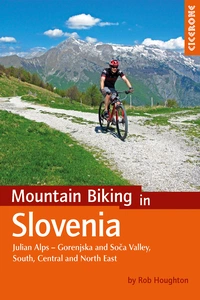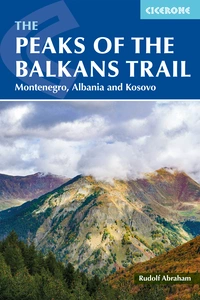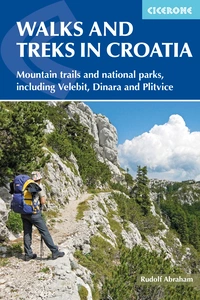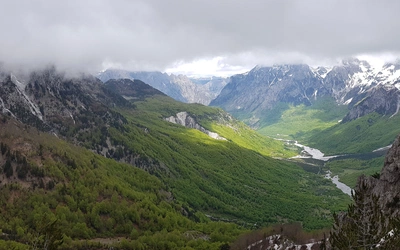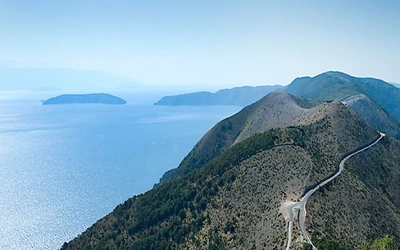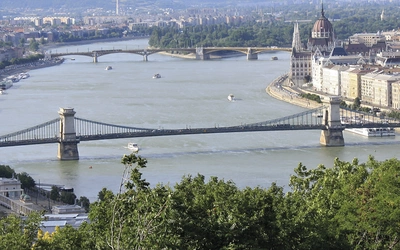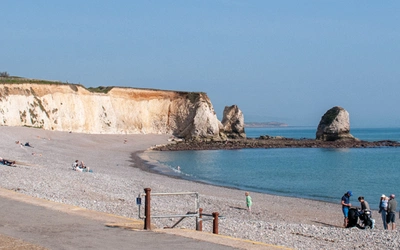Cycling in Montenegro: The Kotor Serpentine
The tiny Balkan nation of Montenegro is making its mark on the tourist map, primarily for historic towns and epic mountain hiking. However, over just a few days Melissa Davies discovered that the coastal mountains make Montenegro a thrilling cycling destination – for those willing to venture off-road, that is!
Montenegro is country number six on an epic drive from Spain to Greece with just the equipment we can carry in our VW campervan. Yet, it’s one of the nations we’re most curious about. Coming from Croatia, a country we know well, the border marks our entry into the unknown. Within minutes of entering Montenegro a vast sloping wall of peaks keeps us pinned to a coastline bursting with Serbian holidaymakers. Only a handful of plucky roads penetrate this coastal barrier, ensuring our journey is dictated by nature. It doesn’t take long for this to become a familiar mantra – one we relish. Our eyes are firmly set on a particularly colourful example of these throughways, the infamous Kotor Serpentine: 8.3km of hairpin bends (16 in total) weaving up above the medieval city of Kotor, eventually extending towards the interior plateau and the former royal capital of Cetinje.
From there we’d venture deeper into the Dinaric Alps that shiver through inland Montenegro and rear to their most mighty in Albania’s Accursed Mountains east of the border. At this point we’ve been travelling through Europe for months but have yet to encounter a single Montenegrin. They’re preoccupied with forging an identity for their ancient but young country, we muse. Whatever the reason, it all adds to the sense we’ve left the familiar, or the comfortable, behind in Croatia. A cyrilic alphabet doesn’t help matters. However, my husband and I are there to cycle so the gradients, the panoramas or the bone-shaking descents will be our language.
Leaving Kotor behind
Initially, the country doesn’t live up to the expectations created by the name Black Mountain, or Crna gora in Serbian. Boka Kotorska (Kotor Bay), while immediately dramatic, is also gentile, more than a little Venetian, and the most intimidating element is, for sure, the eye-watering parking fees around the bay. Slightly overwhelmed by the sheer volume of bodies swarming through the pristine lanes of Kotor’s old town we escape to a rustic campground in the forgotten village of Donji Stoliv, on the furthest reaches of the bay. There, under a canopy of grapevines and pizza smoke, we plan our route.
Being early July, a constant stream of cruise ships drift into the bay like icebergs in Svalbard. In Donji Stoliv, kittens tumble over the pebble beaches illuminated once by the peachy rose sunset and again by neon limelight of drink kiosks, distant engines blending with their animal war cries.
As we stroll the road along the seafront we find ourselves ducking between gorgeous Mediterranean villas with the appearance of protectors to shabby stone cottages and their elderly habitants. Before coming here I’d been unable to imagine this country I knew only from glimpses in Casino Royale (which it turns out was filmed in the Czech Republic). That Hollywood finish doesn’t fit with the recent turmoil of the Balkans and my imagination snags on the rough edge of Eastern Europe. I anticipated a sense of otherness that simply doesn’t align with what I’m seeing in Boka Kotorska.
It takes just 3 miles the following morning for that to change. The slopes are about to reveal the black of their name. I quickly realise that Montenegro is a country of contrasts; scratch the surface to reveal the naivety of a youngster thrust onto the world stage. From Kotor we drive a few short miles to the hamlet of Trojica, where we start our ride, but the drive could have been across a lifetime. Villas give way to concrete shacks, one guarded by a half-dressed child sweeping rubbish from the yard; traffic thins to just us and a walnut-faced man peddling plastic butts of suspect water in a home-made cart. The illusion of Kotor is fading. A mix of curiosity and awkwardness, but mostly a thirst for the mountains is what fills me as I mount my bike and head for the climb.
The Serpentine
Before they built concrete barriers The Serpentine, officially known as P1, would be a white-knuckle ride for very different reasons. Instead, we pedal steadily up a gradual gradient teetering between sheer rock face, walls of coastal pine, dusty viewpoints and the ever-present plunge to Kotor. The bay shrinks rapidly, leaving toy ships and a mosaic of rooftops peppered almost casually under the peaks. The higher we climb the more splendid they become.
I make no attempt to count the bends as we climb, the heat pressing down from a heavy grey sky is enough of a distraction, plus progress is interrupted by viewpoints – located at almost every turn – so I have ample opportunity to catch my breath. The crumbling mass of Trojica was swallowed by trees long before so we’re left with the marble white Kotor tourism wants you to remember. Naturally sheltered, the town’s trading past seems inevitable and here the slopes feel like protection rather than barrier. However, a few sweaty hairpins further and still hundreds of metres of mountains above us, this thought is soon forgotten.
Gradually, the green banks thin to bare rock, the sky opens and a clear blue dominates as far as the eye can bear. The road shrugs off its final turn and we roll freely above the Adriatic Sea. The bizarre shape of the bay is laid out gloriously from this vantage point, mountains echoing into the blue distance beyond. Although they’re only moderate in height compared with the peaks of the interior, the drama comes from their position. Like teeth of a creature submerged, they thrust violently from the water.
We’re elated to see the restaurant a few miles later. In fact, we stop there twice; once for fuel and on the return for views. The wood panelled terrace juts out from the hillside, swollen with sunshine that ripples off the red plastic table covers, making them sticky and warm. Surprisingly, the breathtaking roof terrace, complete with swinging chairs, is deserted and when we ask to sit there, we’re told it’s closed. Although this seems inexplicable, we soon learn that service in Montenegro is ropey at best – heed the warning given by Rudolf Abraham in his Cicerone guide to these mountains, The Mountains of Montenegro.
We keep the summit of Lovćen (which gives its name to the national park) to our right as we trace the edge of the interior plateau towards Njeguši. The tiny mountain village has a big reputation for producing some of the best prust (smoked ham) and sir (cheese) in the country, although this reputation could be something to do with it also being the home of the Petrović family – one of Montenegro’s major ruling families.
I look forward to sampling some mountain produce, but as we roll through the sprinkling of homes a dominant sleepiness hangs in the air absorbing any signs of life. As if in agreement, the tunnel through the hillside at the head of the village is closed and we’re forced to grind a painful route over the pass that winds out of the valley and higher into the pine-green interior.
Cycling along the coast
We’re still only a few miles from the coast, but already Montenegro is shedding its Mediterranean skin to show us the rough landscape of Balkan shepherds and smugglers that reaches deep into the neighbouring countries. These are vistas that intimidate through repetition rather than grandeur. At only 1600-1700m, the mountains are modest, but their relentless peaks create drama out of stamina. The area around Lovćen National Park is the heartland of old Montenegro, where resistance to the Ottomans was strong and they founded their royal capital. Although our route bypasses Cetinje, we’re treated to a panoramic view of the town nesting between the slopes. We strain to pick out the older royal buildings but from our pit stop on the hill this historic centre of resistance is simply a chaos of terracotta roofs bleeding into greyscale suburbs.
Back on the tops we curve south of Lovćen and head towards the coast once more. This is where things take a turn for the wild, but not without reward. Away from the main coastal road these mountains are criss-crossed by miles of tracks, almost all gravel or dirt, pockmarked by hooves and heavy tyre tread. With the afternoon light turning the ochre dirt gold and our gravel tyres in place, it proves too good to resist. We veer off the road to reap the reward of the spontaneous. Make no mistake, the going is tough. Constant climb and descent skittering between loose stones and ruts is exhausting; we pour with sweat under the late afternoon glare, feeling akin to the bleached bodies of silent trucks hulking in the bushes.
Throughout the Balkans we encounter these huge road bashers, piles of tarmac waiting on gravel tracks, as the entire peninsula scrambles to keep up with the growing number of tourists. Away from the coastal resorts, Montenegro is no exception. Therefore, we feel privileged to be here now, riding these deserted lanes with the sprawling maritime mountains washed blue to our left and the only traffic a couple of locals on mopeds sharing the views.
Over the next few days we meander our way along the coast, taking the long route round Boka Kotorska in search of empty beaches (of which there are almost none). During the union with Serbia, Montenegro’s Adriatic coast was the holiday destination for landlocked Serbs. A hangover remains in the packed beaches dominated by bars and an ocean of plastic recliners. Every crescent of shingle has been claimed by an enterprising local but they’re not without hearts. We’re invited, late one violet evening, to camp in the parking area behind one beach club in order to make use of the clean, glassy bay and outdoor showers. After a lot of hand gesturing, he lifts the barrier and we drive in feeling like royalty!
Morača Gorge
Beyond the heaving, sky rise resort of Budva lies one of the only roads to dissect Montenegro's coastal range. Further inland still we skirt around the modern capital of Podgorica following the E80 into the heart of the country, where it reveals its treacherous karst belly. The E80 is one of the country’s most spectacular roads and compulsory if you’re travelling to the Komovi or Prokletije areas or the Kosovo border, as we were. The road plunges drivers hundreds of metres down into the Morača Gorge.
Unfortunately, with it being a major transit artery of the country, cycling isn’t a viable option here – think dodging lorries and unlit tunnels. Instead, we had to content ourselves by joining the stream of traffic crawling along the narrow road.
Once again, the landscape changes. The Morača river swirls over a kilometre down from the rim, teasing the road as it dips between slot canyons and emerges in a burst of adrenaline thrashing against silvery boulders. Skeletal trees cling desperately while others lie defeated, splintered at astonishing heights along the gorge walls.
It’s torturous to be observing from a window, so when we reach the town of Mojkovac, which straddles the powerful Tara river at the mouth of the Tara Canyon (the deepest gorge in Europe), we practically fall out of the campervan to explore. After the claustrophobia of a day spent in the cold shade of the gorge, the open landscape here feels pastoral. It’s impossible to imagine the power of the river a few miles on while we swim on the reedy fringes outside town.
The temptation to alter our plans and head west into the Tara Canyon is strong but the opaque lure of Kosovo proves the stronger pull and the following morning we rise early to drive into the Visitor Mountains and over the border where the Dinaric Alps come to an abrupt end with the Rugova range, giving way to the Kosovan plain and a dense fog we can almost taste.
On leaving the country we’re already planning to return – to the far west and the Durmitor Range in particular. But the next leg of our journey beckons for now, with countries seven and eight still to explore. A continued Balkan flavour in Kosovo and Albania that promises further cycling adventures, stronger coffee and every spectrum of local welcome.
Fancy a hike in Montenegro?
The Mountains of Montenegro
A Walker's and Trekker's Guide
£16.95
This guidebook to Montenegro includes 17 walks and trekking routes throughout the Dinaric Alps, in Montenegro's five national parks as well as Orjen, Komovi, Tara Canyon and the UNESCO-listed old town of Kotor. The circular and linear routes range from easy hour-long outings to challenging 5-day treks involving exposure and scrambling.
More information

